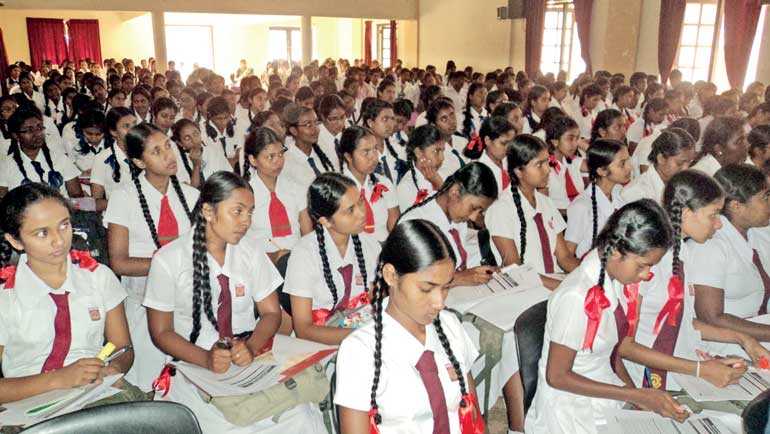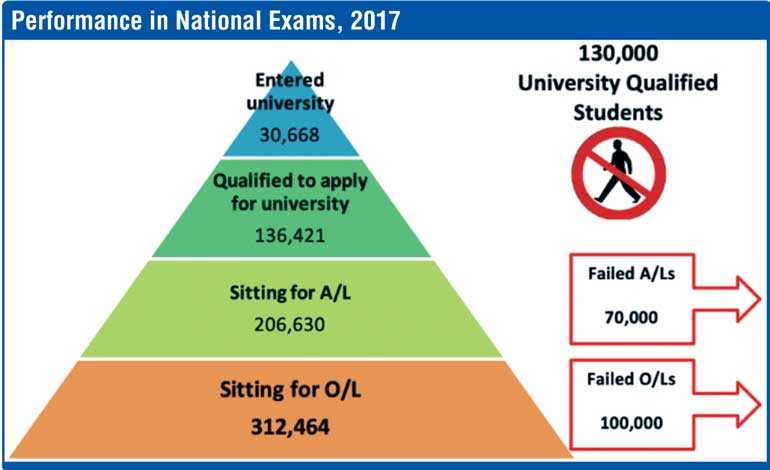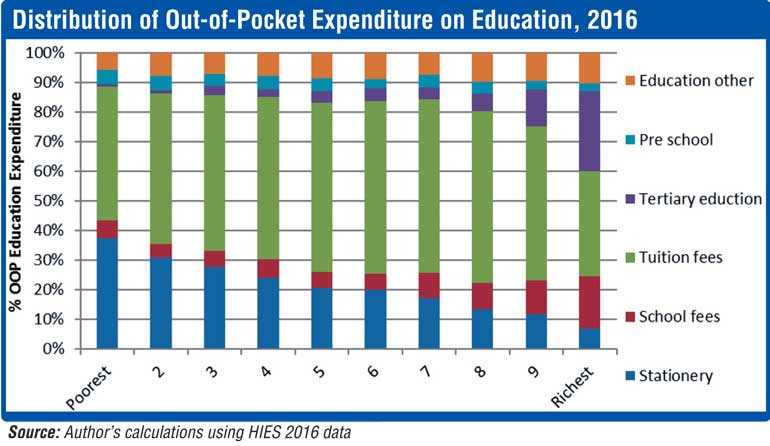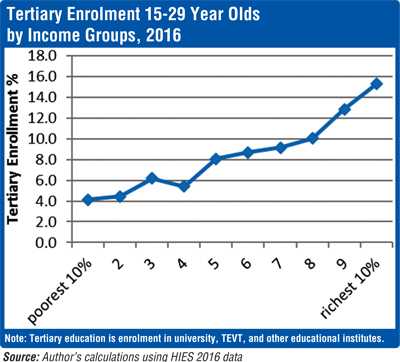Wednesday Feb 12, 2025
Wednesday Feb 12, 2025
Monday, 11 March 2019 00:00 - - {{hitsCtrl.values.hits}}



The Institute of Policy Studies (IPS) team has raised some pertinent points on 2019 Budget proposals on the education sector. Here are the respective comments:
IPS Director of Research Nisha Arunatilake:
Giving a few students opportunities to study in top universities in the world is not a favourable proposal. For one, only a few will benefit from this. Also, there is no guarantee that these students will return to the country. Even if they come back, whether there will be jobs for them to do in Sir Lanka is a concern. It is better to facilitate top class educational facilities within Sri Lanka, and give scholarships for more students to attend those facilities.
The ‘My Future’ initiative in the 2019 Budget is a good proposal. Many who pass A Levels are unable to attend university. This initiative will provide opportunities for students to engage in high quality tertiary education activities outside the universities.
It would have been better to see more initiatives to improve the skills of teachers. The present Budget has allocated money for training in-service teachers. But, the need is also for improving teacher training before individuals are recruited to the teacher service. There is an urgent need to improve the pre-service training of science teachers in the country. Also, recruitment into teacher service needs to be streamlined so that only the best, well trained teachers are recruited into the system.
The Budget proposes to provide vocational training through the involvement of the army. Sri Lanka already has a large network of vocational and technical training institutions. As such, the need for the army to get involved in providing training is questionable.
IPS Research Officer Ashani Abayasekara:
Proposed investments in improving school infrastructure as well as teacher training are welcome initiatives in the 2019 Budget. IPS research shows that students from privileged schools with more infrastructure facilities outperform their less privileged counterparts at nationally competitive examinations such as the O-Levels.
Further, given Sri Lanka’s limited facilities for pre-service teacher training, offered via two avenues—a Bachelor of Education (BEd)and a three-year National Diploma in Teaching (NDT)—the share of suitably trained teachers at recruitment is strikingly low: IPS research reveals that only 45% of science and 16% of mathematics teachers are subject trained at recruitment. As such, as outlined in the Budget, it is important to pursue in-service teacher training programs, while simultaneously working towards expanding pre-service training opportunities.
 The proposed STEM+A master plan, allowing the pursuing of flexible combinations of subjects, is another important proposal, given Sri Lanka’s currently low enrllments in STEM education. However, the effectiveness of this proposal would depend on the ability to expand access to science education at the secondary level; School Census data indicates that currently only 10% of schools are of Type 1AB, offering science streams at the A-Levels.
The proposed STEM+A master plan, allowing the pursuing of flexible combinations of subjects, is another important proposal, given Sri Lanka’s currently low enrllments in STEM education. However, the effectiveness of this proposal would depend on the ability to expand access to science education at the secondary level; School Census data indicates that currently only 10% of schools are of Type 1AB, offering science streams at the A-Levels.
The proposal to modernise the education curricula, with a focus on more analytical and creative learning, as opposed to rote learning, is also noteworthy. Sri Lanka needs urgent reforms in making its education more relevant to meet changing demands in the labour market. According to a World Bank study, currently only around 32% of arts graduates are employed, although 55% of total undergraduate enrolment is in the arts, law, management, and commerce streams. Further, the recent Labour Demand Survey conducted by the Department of Census and Statistics finds that 32.5% of first-time job seekers coming from university or other higher education institutions are poorly prepared, primarily due to lack of job-specific required skills or competencies as well as soft skills. It is however important to spell out how exactly the curricula will be modernised, what new modules will be incorporated, and how learning in specified areas will be measured and evaluated.
A priority area not explicitly addressed in the 2019 Budget is with regard to reducing disparities in access to education. IPS research shows that equitable access to school education decreases in higher grades: A-Level enrolment rates vary from only 29% in the poorest household income decile to 73% in the richest decile. To ensure that all Sri Lankan students have a fair chance of benefitting from proposed scholarship schemes such as the Scholarship for Educational Excellence (SEE) Fund, where top performers at the A/Levels will receive scholarships to pursue undergraduate education at top international universities, access to good secondary and collegiate level education must first be made available.
IPS Research Economist Priyanka Jayawardena:
The proposed STEM+A initiative, which allow students to pursue a combination of subjects such as Mathematics with Music or Biology with English, is welcome. As highlighted in IPS research Sri Lanka has an excess of Arts graduates in the country. Of the university admissions, nearly one-third are Arts graduates. Further, according to Graduate Employment Census 2012, a majority of the unemployed (57%) and underemployed graduates (50%) were from the Arts discipline. Among unemployed Arts graduates, 65% were willing to change the field. Thus, it shows that providing better opportunities to learn market-oriented subjects, such as ICT, in the Arts stream will reduce the mismatch between the demands of the market and the skills of graduates.
Limited enrolment for science related fields at higher levels of education is mainly due to the limited access to A-Level science streams at school level. For example, as of 2015, less than 10%of schools had the facilities to teach A-Level in the science stream. Thus, the proposed initiative to improve laboratories, classrooms, libraries, sanitary and water facilities, teachers’ quarters, etc. is a good move to strengthen access to science education while improving the quality of education.
The proposed loan scheme, ‘My Future’ under ‘Enterprise Sri Lanka’ which enables students to pursue undergraduate education at non-State universities also a good initiative to expand opportunities for skill development. As highlighted by IPS research, each year, about 130,000 students who qualify, have to abandon their ambitions to enter a university.
Further, IPS research shows that the transition from school to vocational training is not smooth. Poor children in particular have limited access to skills development programs. Variations in tertiary enrolments among 15-29 year olds by income groups is quite high in Sri Lanka.
Also, IPS research highlights that it is mostly the richest 20% of households who bear tertiary education related costs. Of the households that spend on tertiary education, on average Rs. 12,930 per month is spent for tertiary education. Given that the average total monthly expenditure of the poorest 10% of households is around Rs. 19,720, affordability of these costs is questionable. As such, these costs may negatively affect school education as well as skill development of poor children.
Discover Kapruka, the leading online shopping platform in Sri Lanka, where you can conveniently send Gifts and Flowers to your loved ones for any event including Valentine ’s Day. Explore a wide range of popular Shopping Categories on Kapruka, including Toys, Groceries, Electronics, Birthday Cakes, Fruits, Chocolates, Flower Bouquets, Clothing, Watches, Lingerie, Gift Sets and Jewellery. Also if you’re interested in selling with Kapruka, Partner Central by Kapruka is the best solution to start with. Moreover, through Kapruka Global Shop, you can also enjoy the convenience of purchasing products from renowned platforms like Amazon and eBay and have them delivered to Sri Lanka.
Discover Kapruka, the leading online shopping platform in Sri Lanka, where you can conveniently send Gifts and Flowers to your loved ones for any event including Valentine ’s Day. Explore a wide range of popular Shopping Categories on Kapruka, including Toys, Groceries, Electronics, Birthday Cakes, Fruits, Chocolates, Flower Bouquets, Clothing, Watches, Lingerie, Gift Sets and Jewellery. Also if you’re interested in selling with Kapruka, Partner Central by Kapruka is the best solution to start with. Moreover, through Kapruka Global Shop, you can also enjoy the convenience of purchasing products from renowned platforms like Amazon and eBay and have them delivered to Sri Lanka.